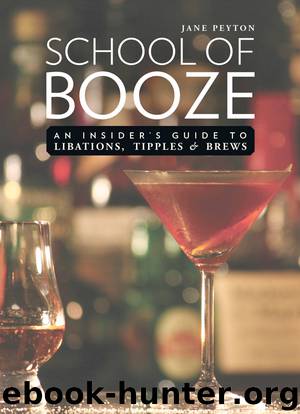School of Booze by Jane Peyton

Author:Jane Peyton
Language: eng
Format: epub
Publisher: Skyhorse Publishing
Published: 2014-12-31T16:00:00+00:00
Where grapes were not plentiful, distilled alcohol was made from cereals instead. Thus in Southern Europe the national distilled drinks—brandy, grappa, ouzo were made by distilling fermented grape juice; but in the colder climes of Northern Europe whisky, vodka, gin, genever, aquavit were made by distilling barley, corn or wheat.
HOW DISTILLATION WORKS
Depending on what spirit is being produced, grapes, apples, soft fruits, cereals, molasses, potatoes, or some other source of sugar are fermented. Alcohol is the by-product. Simple distillation is performed in a pot still (a.k.a. alembic) which consists of two flasks connected by a tube. In the first flask the fermented liquid is boiled so the water, alcohol and aroma compounds vaporise and accumulate in the tube where they condense on a cold serpentine coil. Condensate of concentrated alcohol trickles drop by drop into the second flask. The first run-off is called ‘the head’ and being low grade is discarded because the distiller is after ‘the heart’ which is the high-quality distillate in the middle of the process to be used as the final product. During distillation chemical reactions take place that change the aroma and flavour characteristics of the original fermented brew. The condensed liquid is a colourless spirit, so for drinks like whisky, rum and brandy it is aged in oak casks for several years and the wood imparts a golden amber hue, aroma and flavour. With gin, anise and flavoured vodka, the spirit is either distilled again or infused with botanicals to give the distinctive flavours.
Download
This site does not store any files on its server. We only index and link to content provided by other sites. Please contact the content providers to delete copyright contents if any and email us, we'll remove relevant links or contents immediately.
| Buying Guides | Cellars |
| Champagne | Collecting |
| Spirits | Whiskey |
| Wine | Wine Pairing |
| Wine Tasting |
101 Whiskies to Try Before You Die by Ian Buxton(44794)
World's Best Whiskies by Dominic Roskrow(44734)
Whiskies Galore by Ian Buxton(41871)
Craft Beer for the Homebrewer by Michael Agnew(18140)
Right Here, Right Now by Georgia Beers(4124)
Not a Diet Book by James Smith(3335)
Water by Ian Miller(3126)
The Coffee Dictionary by Maxwell Colonna-Dashwood(3062)
Kitchen confidential by Anthony Bourdain(3007)
Coffee for One by KJ Fallon(2563)
Smuggler's Cove: Exotic Cocktails, Rum, and the Cult of Tiki by Martin Cate & Rebecca Cate(2469)
Superfood Smoothie Bowls: Delicious, Satisfying, Protein-Packed Blends that Boost Energy and Burn Fat by Chace Daniella(2387)
Talking as Fast as I Can by Lauren Graham(2380)
Beer is proof God loves us by Charles W. Bamforth(2370)
Bourbon: A Savor the South Cookbook by Kathleen Purvis(2244)
A Short History of Drunkenness by Forsyth Mark(2233)
Eat With Intention by Cassandra Bodzak(2154)
Cocktails for the Holidays by Editors of Imbibe magazine(2081)
Colombia Travel Guide by Lonely Planet(2061)
